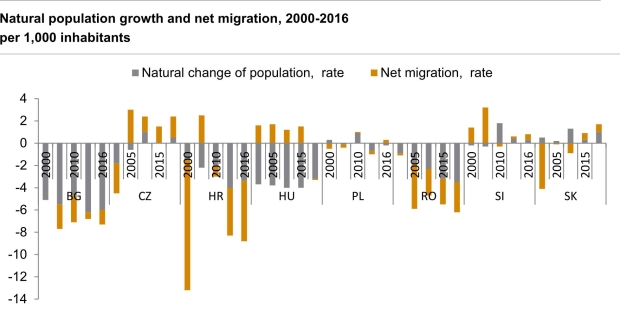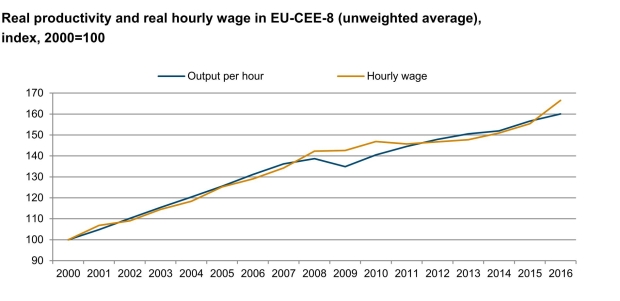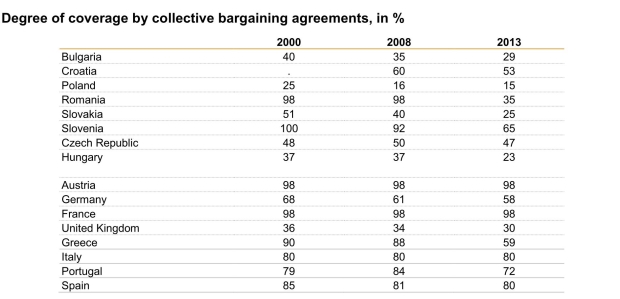Solving the mystery of weak wage growth in EU-CEE
20 January 2020
Earnings have been slow to respond to tight labour markets because of the reforms which have reduced labour’s bargaining power.
By Vasily Astrov
photo: iStock.com/ivan-balvan
- In the context of rapidly tightening labour markets, real wage growth in EU-CEE was until recently remarkably subdued.
- A new wiiw study finds that the Phillips curve does not hold for EU-CEE, with the exception of the Czech Republic and Slovenia, the region’s two most developed countries.
- Our study argues that this is mainly due to post-crisis labour market reforms aimed at increased flexibility and the liberalisation of wage-setting mechanisms. The decentralisation of wage bargaining has prevented bigger wage increases.
- In addition to increased labour market flexibility, reductions in unemployment benefits and the creation of a two-tier labour market have also reduced workers’ bargaining power, especially for lower-skilled employees.
- Our study concludes that many of these reforms must be reversed. In order to tackle the huge challenges that EU-CEE faces—emigration, slow convergence, population ageing, and excessive dependence on external demand—strong, centralised collective wage bargaining is needed.
Labour markets across much of EU-CEE have tightened significantly in recent years. To a large extent, this reflects a combination of natural population decline and negative net migration over recent years (see chart below). Continuous emigration has further exacerbated the decline in population, as the emigration of the youngest and most productive age group has contributed negatively to birth rates. Immigration to the EU-CEE 8 (all EU members in the region excluding the Baltics) from neighbouring countries to the east and southeast has also gained momentum. Poland, for example, has recorded significant immigration from Ukraine, the Czech Republic from Slovakia and Ukraine, Hungary from Slovakia and Romania (mainly the Hungarian-speaking minority), and Croatia from Bosnia and Herzegovina. Nevertheless, most EU-CEE countries remain net exporters of migrants, mostly to Western Europe.
Adverse demographic trends and massive outward migration have resulted in a steep decline in the working-age population and, coupled with surging labour demand in the wake of economic upswing, led to a marked decline in the unemployment rate in the EU-CEE-8. Unemployment rates fell by a total of 4.5 percentage points on average between 2010 and 2016, to 7.6%. The Czech Republic and Hungary currently have unemployment rates of 3% to 4%, respectively, indicating almost full employment. This has been accompanied by mounting labour shortages, especially of skilled workers. These trends are expected to persist in the long term.
So where is the wage growth?
The fact that this has not translated into higher wage growth is, at first glance, very surprising. Until recently, real wage growth in the region was fairly subdued. This applies above all to the four Visegrád countries (Czech Republic, Hungary, Poland and Slovakia), where in recent years wages have on average grown by almost one percentage point per year less than GDP. In Romania and Bulgaria, wages have risen more quickly, albeit from a much lower starting point and to a large extent thanks to minimum wage hikes. For the EU-CEE-8 region as a whole, productivity and wage growth have generally risen hand in hand since 2000 (see chart below), although 2016 saw a certain upturn in wages. As a result, the wage share in GDP for the region in 2016 (34.2%) was basically unchanged from 2000 (34%).
Our econometric (VAR) estimations indicate that the Phillips curve, which suggests a negative correlation between unemployment and wage growth, does not hold for most EU-CEE countries (with the exception of the relatively more developed Czech Republic and Slovenia). Unlike in these two countries (or Austria and Germany, for that matter), the transmission mechanism on which the Phillips curve is based barely exists in the rest of the region, at least during the period in question: the improvement in labour market conditions did not lead to higher wage settlements. Instead, there is econometric evidence that the opposite has been the case: higher wage settlements have been a drag on the decline in unemployment, probably due to redundancies in response to higher wage costs. Without this latter effect, the improvement in labour market conditions in most EU-CEE-8 countries would have been even more impressive than it actually was.
Institutional factors are to blame
Our new study argues that the meagre wage growth in EU-CEE-8 has been primarily caused the increased liberalisation and flexibility of regional labour markets. Partly in response to the economic crisis of 2008-2009, labour market institutions were often transferred from the national and sectoral to the firm level. Collective bargaining mechanisms, which had been already weaker than in Western and even Southern Europe at the onset of the economic crisis, were weakened further, in some cases dramatically, such as in Romania and Slovenia (see table below). In Hungary and Bulgaria, too, the degree of coverage by collective bargaining agreements dropped from around 40% before the crisis to below 30% afterwards. These reforms were accompanied by a falling degree of organisation of both employees and employers, resulting in the decentralisation of wage bargaining. Slovenia is the only country in the EU-CEE region where wages are negotiated exclusively at the sectoral level and individual sectors coordinate wage negotiations.
In addition to this, in a few EU-CEE countries there has been a reduction in the size and duration of unemployment benefits, combined in the case of Hungary with the obligation to take up work in municipal projects. This has contributed to a reduction of unemployment, but created at the same time a two-tier labour market that exerts a direct dampening effect on wages, especially of the less-educated labour force. Taken together, these reforms have weakened the bargaining power of employees.
The way forward
On the positive note, official minimum wages have been hiked over-proportionately in the majority of EU-CEE countries since 2010, both as a means to combat income inequality and to support domestic demand. This has not only led to a compression at the lower end of wage distribution, but also fuelled overall wage growth, particularly in countries where wages and salaries in the public sector are automatically indexed to the minimum wage, such as in Romania.
However, this alone will not ensure a more sustainable way forward. Higher minimum wages cannot be a substitute for the important macroeconomic stabilisation function of coordinating labour market institutions. Such institutions are particularly important in view of the specific challenges faced by the EU-CEE region: emigration, productivity growth which is not fast enough to ensure rapid convergence to West European levels, population ageing, and excessive dependence on external demand.



